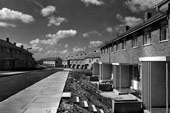Essay Part 1 | Essay Part 2 | Essay Part 3 | Essay Part 4
Housing Associations
The Housing Corporation was established by the 1964 Housing Act and was proactive in funding andpromoting housing associations. Many HAs were set up and architects were much involved in their growth. Phippen Randall & Parkes was fortunate to engage with some visionary clients, including Michael Baily, transport correspondent for The Times, who had been stimulated by the adaptable housing concept and was convinced that better designed communities could be developed for saleand rent. He explored local market opportunities with an advert in a local paper, followed it up with a short sociologist / architect questionnaire and then embarked with us on the development of The Ryde housing development at Hatfield.
The climate of the time supported initiatives of this kind by helping with sites at affordable levels, and with funding. Housing associations and development corporations were characterised by a determination to maintain decent standards and, where possible, to build long-term relationships with their professional teams. Joint experience was conserved and briefs developed for subsequent projects with realistic information from themanagement team, tenants and designers.
Local Authority Skills
The level of housebuilding activity by local authorities at this time is well documented, butit is worth stressing that the level of expertise in authorities such as the GLC, London boroughs and other cities was formidable. The continuity of exceptional chief officers and members withdirect experience of the tenants and performance of their stock provided highly informed crits forthe architects presenting their ideas to committee. Much of the resulting housing was procured swiftly by these teams. High-rise failures have obscured the many successful and well-liked low-riseadditions to the national stock.
Encouraged by central government, local authorities were also active in promoting lowrise solutions using steel and timber as well asconcrete. They joined forces to form purchasing consortia for off-site building methods andassembled programmes large enough for manufacturing firms to set up production lines. Contractors such as Llewellyn developed and marketed a timber-frame system made in the Quikbuild factory and assembled on site by their own teams - fast carcass assembly to be clad and roofed by a general contractor.
Then, as now, to achieve the real benefits offactory production there had to be sufficient continuity to maintain an adequate flow of orderswithout constant stop / starts and tailor-made specials. The manufacturing initiatives falteredbecause there were too many firms with bright ideas in prototype competing for a programmethat could not sustain them all. Worthwhile methods were lost, not helped by the increasing commitment to high-rise systems.
New Towns
New Towns followed on from the earlier Garden Cities to produce new balanced communities at a fast pace throughout the 1950s and 1960s. Talented professional teams were built up within the development corporations which became highly effective organisations that produced an unequalled quality of mixed social development. When they were finally wound up and the skills dispersed, they were not replaced by organisations of equally productive effectiveness and balanced talent. Designers no longer occupy lead positions in the new procurement models, and it is beginning to show. If our new communities are to match the New Town achievements, some visionary thinking is needed to improve methods now in use.
Back to top
Essay Part 1 | Essay Part 2 | Essay Part 3 | Essay Part 4

